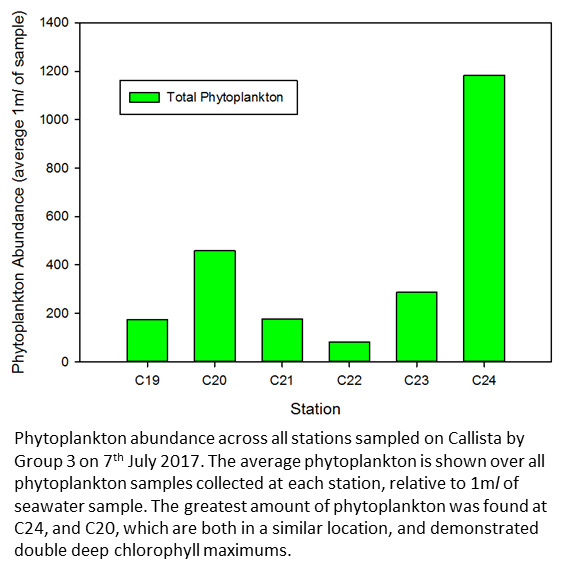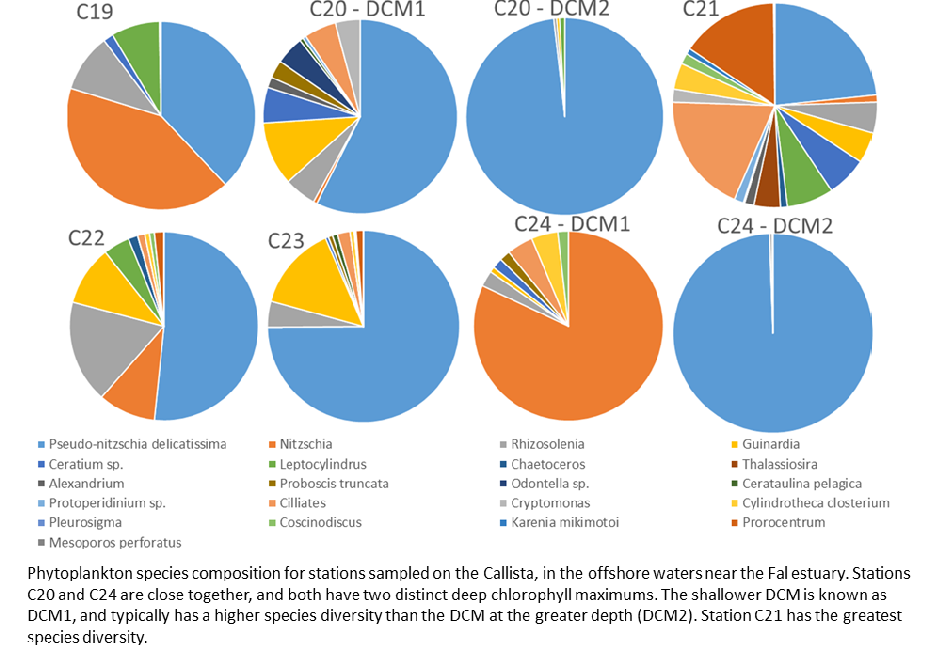





The offshore involves a transition from the well mixed near-shore into a highly stratified system with a strong tidal front barrier. The Callista explored this along a South Easterly transect consisting of 6 stations and two minibat lines, with adjustments to its path made based on conditions (Link to map). Previous groups had sampled along Easterly and Southerly transects earlier in the week and these station points are mapped below as a comparison.
This path was chosen with the following hypothesis in mind: ‘with distance offshore, sea surface temperature will increase, mixing will reduce and stratification will strengthen, in turn giving rise to a subsurface or deep chlorophyll maximum.’
Date: 07/07/17
Time: 08:00 - 19:30
Vessel: Callista
Low Tide: 10:27 UTC (1.11m)
High Tide: 16:17 UTC (4.76m)
Low Tide: 22:49 UTC (1.10)

At each station a rosette was deployed recording CTD data and allowing the determination of where to fire niskin bottles to obtain samples for later lab analysis (have link to lab protocol). This excluded Station C23 whose CTD deployment was used to determine the water column profile prior to deploying the minibat. The number of Niskin bottle samples per site varied from two to four dependent on the observed features and level of stratification. For each bottle, a water sample was extracted for nitrate, silicate and phosphate analysis, oxygen concentration, phytoplankton and 3 GF filters obtained for determining the chlorophyll concentration. All the procedures applied were the same as those used on the vessels Bill Conway and Winnie the Pooh for the estuarine study (link to estuary methods).
In order to study the zooplankton a plankton net was deployed and run vertically through a selected zone of interest at stations C19, C20, C21 and C22. Again, the downcast of the CTD allowed for a decision on what depths to obtain these samples from – selected at areas of high fluorescence, indicative of the deep chlorophyll maximum.
The minibat was towed along two transects forming a cross at which station C24s CTD and samples were taken (map). The idea was to obtain a cross section through the water column allowing for visualisation of physical and biological changes in space with movement across the tidal front. The cross for the minibat tows was also selected based on the unusually high peak of fluorescence (~0.59 mg/m3) observed at 30m at station C20.

Stations C20 and C24 have shown high levels of chlorophyll readings, which correlate to the very high abundance in phytoplankton observed from the samples collected at those stations. All stations except stations C19 and C22 demonstrated the existence of a deep chlorophyll maximum (DCM). Phytoplankton need both light energy and nutrients in order to survive, and therefore are often found to be most abundant where those two factors are present. Therefore, the DCM typically occurs at the boundary created by the thermocline, which separates the warm upper layer, that receives a lot of light energy, and the nutrient-rich bottom layer (Olita et al., 2016). Stations C20 and C24 showed the greatest increase in phytoplankton abundance from
Throughout the offshore samples, diatom Pseudo-nitzschia delicatissima was often the dominant species. They were especially abundant at stations C20 and C24. Pseudo-nitzschia delicatissima abundance was greater than all other phytoplankton species combined at all stations except C19 and C21. Station C19 was closest to the Fal estuary, and was likely to have been influenced by the increase in nutrient input from the river system. The percentage of P. delicatissima relative to other species was the smallest at Station C21, which is likely due to the high species diversity found at that station (18 species found in total over 3 samples). At stations C20 and C24, there were two distinct populations of phytoplankton observed at each DCM. At both stations with two distinct DCM layers, the shallower DCM had less P. delicatissima and high species diversity than the DCM at the greater depth. This was especially obvious in the shallower DCM at Station 24, which had no P. delicatissima in its phytoplankton sample. At each station with two pronounced DCM layers, the DCM at the greater depth was almost completely composed of P. delicatissima, and had very few individuals that were of a different species.

the surface to the DCM. These stations were close to each other, and showed unusually deep and pronounced peaks in fluorescence according to the CTD readings.


Spring blooms are often dominated by diatoms such as Pseudo-nitzschia delicatissima, as diatoms are best adapted to high productivity conditions (Widdicombe et al. 2010). They tend to overwhelm the rest of the phytoplankton and create blooms with very low species diversity as they can grow and propagate faster during the spring months, when conditions provide lots of nutrients as well as light. After spring blooms, diatoms are usually very scarce (Holligan et al., 1984), as other phytoplankton species that are better adapted to less productive conditions become more successful. The two distinct deep chlorophyll maximum layers observed at stations C20 and C24 are likely to be the remains of the spring bloom earlier this May or June that have been forced down by tides or waves, and sunk deep into the water column. The shallower DCM is a more typical population of phytoplankton during the summer, with a higher species diversity and less diatoms.

Tidal mixing fronts have long been observed in the western English Channel (Hill, et al., 1993; Smyth, et al., 2010) and our observations of temperature offshore of Falmouth clearly indicate the presence of a tidal mixing front.
In order to quantify the degree of stratification we have taken 5m as a surface temperature and 30m as a deep temperature, and calculated the difference between them. Plotting this for each station moving progressively away from shore shows an increase in the strength of stratification up until the open ocean. This is supported by depth profiles for temperature where it can clearly be seen that station C19 closest to shore is the least stratified and C21 furthest from shore has the strongest stratification. This may indicate an area of water well mixed by tidal forcing and winds closest to shore and then a front of water stratified by solar inputs of heat further out in the English Channel.

An Acoustic Doppler Current Profiler (ADCP) was used to measure magnitude and direction of flow velocity. Combining this data with density measurements recorded by the CTD allows the Richardson number (Ri) to be calculated. The Ri can be used to determine whether the water column is mixing or if stratification is preventing turbulence. Labelled on the figures are the critical values of 0.25 and 1. Ri values below 0.25 suggest mixing is occurring and above 1 stability is implied, a transition zone exists between these values. Ri values larger than 10 have been set to 10 to show stability whilst allowing the transition zone to be seen.
Station C20 is a repeat station which has been sampled for the past several years, this enables a time series to be built up.

 The vertical profile of temperature (Figure 7a) shows a surface mixed layer of 6m,
this is supported by calculated Ri values. Below this the thermocline is present,
this section of the water column is characterised by a gradient in temperature. Within
the thermocline, values of Ri are greater than 1 indicating stability, which is expected
during stratification.
The vertical profile of temperature (Figure 7a) shows a surface mixed layer of 6m,
this is supported by calculated Ri values. Below this the thermocline is present,
this section of the water column is characterised by a gradient in temperature. Within
the thermocline, values of Ri are greater than 1 indicating stability, which is expected
during stratification.
At depths greater than the thermocline, the water column is mainly mixed, apart from a thin layer where a high Ri value is calculated.

A temperature gradient of roughly 0.5oC was measured just below 50m, this is accompanied by Ri values suggesting stability. Flow velocity from the ADCP (Figure 8) shows a water layer at the bottom with slower flow than the water column above. This layer is likely to be generated by tidal mixing. Turbidity (Figure 7b) in this layer shows a peak of 0.274 NUT, this backs up the hypothesis that the layer is undergoing mixing as particles are entrained in the water.
The ADCP data (Figure 8) also shows a region of the water column around 16m with high flow velocity this coincides with the thermocline.
Fluorescence values measured at C20 are unusually high (Figure 7a). Typical values range from 0.000 – 0.300 mg/m3, on the 07.07.17 maximum fluorescence was recorded at 0.425 mg/m3. More data is required to determine the reason for this increase.

At Station C22 a surface mixed layer is less obvious. The top 20m of the water column is predominantly stable beneath which mixing takes place (Figure 9).
Peak of fluorescence at Station C22 occurs at 25m (Figure 9) this is also higher than the typical range. Using fluorescence as a proxy for chlorophyll suggests the presence of a deep chlorophyll maximum (DCM) at this location.
Temperature measurements aren’t as smooth for this station as others, this could result from movement of the boat.
The surface mixed layer at Station C24 (Figure 10) is about 4.5m deep. As with the other stations the calculated Ri values show stability in the thermocline.
At C24 the water column below the thermocline is indicated as being stable (Figure 10) is this different to what is happening at Station C22 (Figure 9).
Two peaks in fluorescence exist one of 0.311 mg/m3 at 29m and the other of 0.208 mg/m3 at 31m.
These peaks are both present just beneath a thin layer of stability.







Figure 11 - The abundance of species present in the water samples collected at each station from the zooplankton net,
The amount of each zooplankton species per litre in the water column could not be calculated as a vertical Zooplankton net was used and required data for the calculation of volume of water sampled were not taken, the use of a flowmeter for example would have allowed this. Therefore, the presence of zooplankton species and their relative amounts within the sample taken at each station can be used. As can be seen in Figure 11, Calanoid Copepods were most abundant relative to other species at station C20 and except for C21 which was dominated by Copepoda Nauplii, Calanoid Copepods were the most abundant in the Zooplankton samples collected, so the dominating species is mostly the same for each site offshore. There are slight fluctuations in presence and abundance of species across the sites, but only two species are present at every site (Calanoid Copepods and Copepoda Nauplii).
Although the number of species present in the water column cannot be accurately calculated due to the collection method used, the pie charts shown in figure 11 allow some inference of the relative abundances of the zooplankton at each station.
Hill, A. E., James, I. D., Linden, P. F., & Matthews, J. P. 1993. Dynamics of tidal mixing fronts
in the North Sea. Philisophical Transactions: Physical Sciences and Engineering, 343, 431-446.
Holligan, P. M., Harris, R. P., Newell, R. C., Harbour, D. S., Head, R. W., Lindley, E. A. S., Lucas, M. I., Tranter, P. R. G. and Weekley, C. M. 1984. 'The vertical distribution and partitioning of organ carbon in mixed, frontal and stratified waters in the English Channel'. Marine Ecology Progress Series. 14, 111-127.
Olita, A., Capet, A., Claret, M. et al. 2016. 'Frontal dynamics boost primary production in the summer stratified Mediterranean sea'.Ocean Dynamics. 67 (6), 767-782.
Simpson, J.H, Hunter, J.R. (1974). ‘Fronts in the Irish Sea’. Nature. 250, 404–406.
Smyth, T., Fishwick, J., AL-Moosawi, L., & Cummings, D. 2010. A broad spatio-temporal
view of the Western English Channel observatory. Journal of Plankton Research, 32(5), 585-601.
Su, Y.J & Cho, Y.K. 2010. ‘Tidal Front and its Relation to the Biological Process in Coastal Waters’. Ocean Science Journal. 45 (4), 243-251.
Widdicombe, C. E., Eloire, D., Harbour, D., Harris, R. P. and Somerfield, P. J. 2010.
'Long-term phytoplankton community dynamics in the Western English Channel'. Journal
of Plankton Research, 32 (5), 643-655.

of group 3 and not necessarily those of the University and NOC
Temperature gradient for all 6 stations sampled by Group 3 on Callista (07/07/2017). The gradient of the thermocline, that marks the point of straitification between the top layer and bottom layer, is an indicator of a tidal mixing front that occurs offshore of Falmouth. The greater the temperature difference, the more stratification in the water column there is. Stations C20 and C24 are repeat stations, as they were in the same place, while C19 is the closest to shore. C21 was the furthest away from shore, and has the greatest temperature difference from the surface to the deeper water, meaning its waters are the most strongly stratified.
